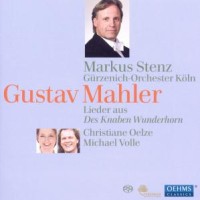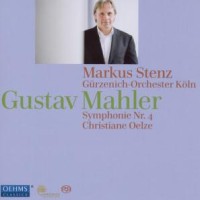Mostly Symphonies 23.
|
Grant Chu Covell [July 2013.]
Dmitri SHOSTAKOVICH: Symphony No. 7, “Leningrad” (1941). Mariinsky Orchestra, Valery Gergiev (cond.). Mariinsky SACD MAR0533 (http://www.mariinskylabel.com/). We marvel at the first movement’s interrupting march. Other than that perverse theme and non-variations, it’s hard to imagine that this would become a non-native’s favorite. Presumably Russians have an emotional view into the symphony that Shostakovich began composing during the siege of Leningrad. What ought to sustain interest is the expressive possibilities of the rest of the gigantic work (82:19 in total). Compared to his earlier recording, Gergiev is mellower, with the Mariinsky sounding warmer and more sensitive. There is a section like light snow falling in the second movement Moderato (around 8:40 in the older, at 10:15 in the newer) with harps, flutes and clarinets in far better balance. Gergiev’s vocalizations are slightly audible. Shostakovich: Symphony No. 7 (1941)
Gustav MAHLER: Songs from Des Knaben Wunderhorn (1892-1901); Adagio from Symphony No. 10 (1910). Magdalena Kožená (sop), Christian Gerhaher (bar), The Cleveland Orchestra, Pierre Boulez (cond.). Deutsche Grammophon 0289 477 9060 GH (1 SACD) (http://www.deutschegrammophon.com/). Gustav MAHLER: Songs from Des Knaben Wunderhorn (1892-1901). Christiane Oelze (sop), Michael Volle (bar), Gürzenich-Orchester Köln, Markus Stenz (cond.). Oehms Classics OH 657 (1 SACD) (http://www.oehmsclassics.com/). DG’s 12-song collection presents the post-1901 group where Revelge and Der Tambourg’sell replace Urlicht and Es sungen drei Engel (which had found their way into the Second and Third). Oehms’ set omits Es sungen drei Engel from the 1899 collection but keeps Urlicht, adds Revelge and Der Tambourg’sell, and includes Das himmlische Leben (essentially the Fourth’s finale) for a total of 14 songs. Oelze and Volle take Trost im Unglück, Lied des Verfolgten im Turm and Verlor’ne Müh as duets. There are no duets in Kožená and Gerhaher’s dozen. After Gerhaher’s smooth tone, the Tenth’s Adagio operates as a 24-minute bonus. For Boulez, this is Mahler’s alpha and omega. The notes reveal Boulez will have none of the Tenth completions. Oelze and Volle offer a strong introduction to these songs. However, the Cleveland’s superlative ease and balance edge out the Gürzenich team. Perhaps unfairly, Thomas Quastoff tops my list for these songs (with Anne Sofie von Otter, Claudio Abbado leads the Berliner Philharmoniker on the 1999 DG 0289 459 6462).
Gustav MAHLER: Symphony No. 1 (1887-88). Bamberger Symphoniker, Jonathan Nott (cond.). Tudor 7147 (1 SACD) (http://www.tudor.ch/). Gustav MAHLER: Symphony No. 1 (1887-88). Budapest Festival Orchestra, Iván Fischer (cond.). Channel Classics CCS SA 33112 (1 SACD) (http://www.channelclassics.com/). Among recent Firsts, these two remain in the house. Nott gets the edge simply because Channel’s spacious recording blurs at the perimeter. The Budapest strings are warmer than the Bambergers, and Channel’s first and last movements’ “awakenings” glow nicely. A diehard Mahlerian, I nonetheless yearn to red pencil the last movement, and so listen more attentively to the central movements for which Nott provides superior balance. The notes do confirm that Tudor’s several recording sessions belie a boomier acoustic in the Finale. Mahler: Symphony No. 1 (1887-88)
Gustav MAHLER: Symphony No. 4 (1901). Miah Persson (sop), Budapest Festival Orchestra, Iván Fischer (cond.). Channel Classics CCS SA 26109 (1 SACD) (http://www.channelclassics.com/). Gustav MAHLER: Symphony No. 4 (1901). Jeannette Wernecke (sop), Stuttgarter Philharmoniker, Gabriel Feltz (cond.). Dreyer Gaido CD 21072 (1 CD) (http://www.dreyer-gaido.com/). Gustav MAHLER: Symphony No. 4 (1901). Christiane Oelze (sop), Gürzenich-Orchester Köln, Markus Stenz (cond.). Oehms Classics OH 649 (1 SACD) (http://www.oehmsclassics.com/). In Mahler’s Fourth, anticipation is shaped by the opening flute and sleigh-bell tempo, and the violins’ entry immediately following. Stenz feels too slow and the violins’ upward curve can’t rebound. Fisher begins briskly and sneaks a portamento into the fourth measure’s arrival. Feltz starts excruciatingly slow even though he quickly and effectively conjures a winter scene. Performers ought to follow composers’ intentions. Fischer’s is the most precise reading albeit with a few confident digressions. The first movement may be Mahler’s most chamber-like statement requiring transparency and shifting balances. I heard fresh details with Fischer, not as much with Stenz and Feltz. In the scherzo, the Budapest’s scordatura violin is deliciously acid and the later pairing with horn quite magnificent. From symphony to symphony, Mahler’s slow movements become more melancholic. The theme and variations shouldn’t be overblown when the curtains are parted for glimpses of heaven. Perhaps Feltz’s live performance necessitated overdoing the bright climax. Neither Stenz nor Fischer seemed to overdo the effect. They’re perhaps saving the dramatics for the Second or Eighth. While I’m not quite taken by the overly bright Persson, I want to recommend Fischer’s Fourth. Oelze isn’t childlike either, but she convincingly explores the role and introduces fresh expression. Mahler: Symphony No. 4 (1901)
Gustav MAHLER: Symphony No. 9 (1909-10). Royal Stockholm Philharmonic Orchestra, Alan Gilbert (cond.). BIS SACD 1710 (1 SACD) (http://www.bis.se/). Gustav MAHLER: Symphony No. 9 (1909-10). Los Angeles Philharmonic, Gustavo Dudamel (cond.). DG 0289 479 0924 02 (2 CDs) (http://www.deutschegrammophon.com/). Dudamel shows us that Mahler’s Ninth isn’t necessarily an old person’s symphony. His reading is convincing and the LA Phil sounds fantastic. However there are spots in the Andante comodo and the final Adagio where Dudamel’s expressive zeal causes the music to fall to the floor. Gilbert is appropriately expressive, but his Ninth is also about life and passion, not just weltschmerz and all the stuff folks either love or loathe about Mahler. The RSPO may have less string oomph (listen to the way the LA strings surge just after the opening bassoons in the Ländler) but they present a more complex texture and react to Gilbert’s fluid tempos in the most manic of the central movements. The RSPO is ok with feeling lost and frantic, whereas the LA Phil is not. BIS crams 82:22 into one disc and DG requires two (45:59 + 40:07). Mahler: Symphony No. 9 (1909-10)
[More Grant Chu Covell, Mostly Symphonies]
[More
Mahler, Shostakovich]
[Previous Article:
Pièces de Clavecin 7.]
[Next Article:
Scardanelli’s Motley]
|









